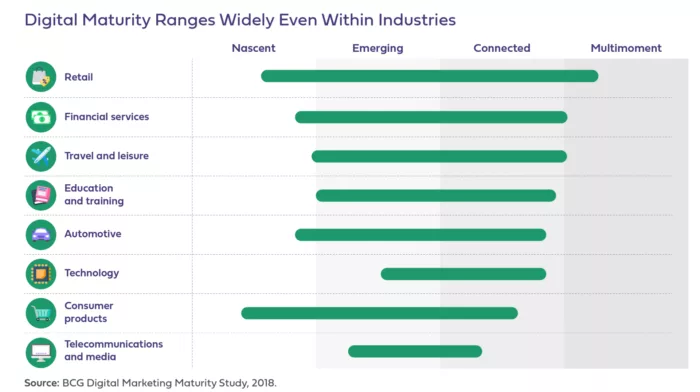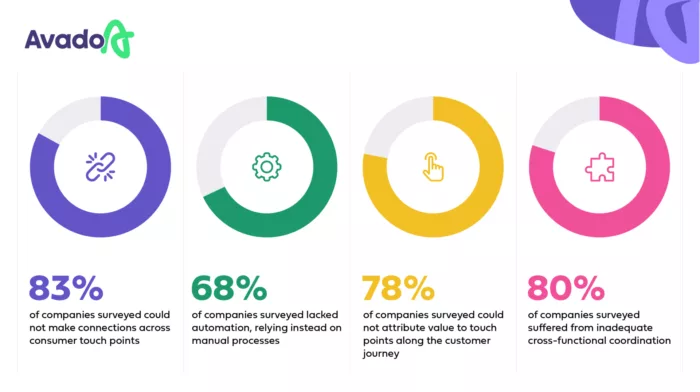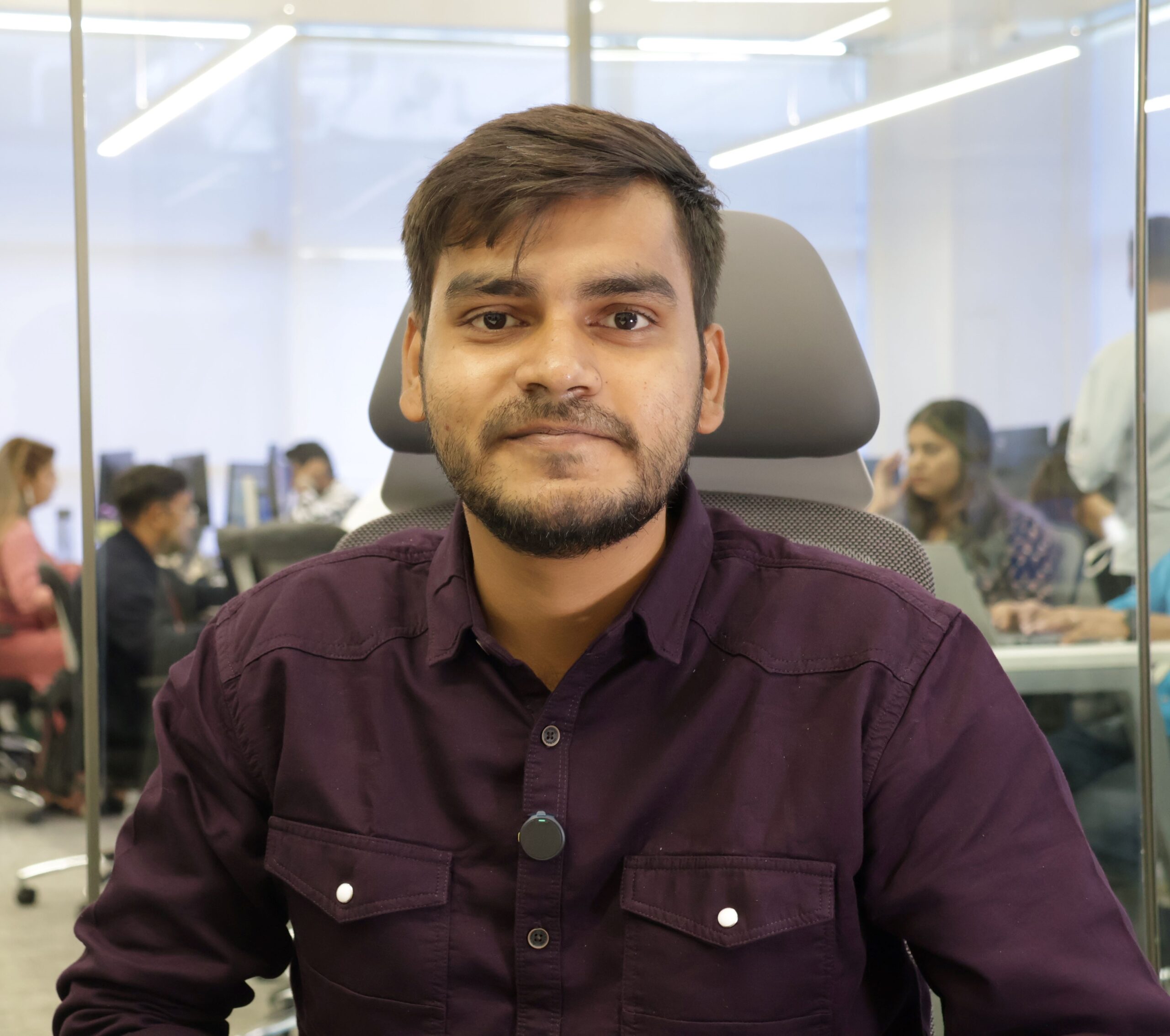Defining common marketing terms and phrases isn’t always straightforward. Digital marketing maturity is probably one of those phrases that stumps you, and that’s legitimate, because it is nuanced. But, it’s an important one for a digital marketer to know, and even more important is knowing how to achieve it. Especially in the current space, where 90% of brands haven’t yet reached the final stage of digital marketing maturity, your organisation can really get ahead with a certain set of tools and knowledge. Read on to find out what it takes to reach maturity and achieve your organisational goals.
What is digital marketing maturity?
Simply put, digital marketing maturity happens when an organisation is able to deliver the right kind of content at the right time (or times) during a customer’s purchasing journey. Very few companies are able to call themselves digitally mature at this point—last year, a study completed through a partnership between BCG and Google that involved a survey of 200 organisations demonstrated that. 90% of the brands included fell into the middle two of the four stages within the digital maturity model, and only 2% had achieved full digital maturity. Those stages, collectively called the digital maturity model, can help an organisation better understand where they are now, and plan for where they want to be.
What is the digital maturity model?
As with any organisational mission, there are several points along the journey to achieving full digital marketing maturity. This journey is marked by four levels, or stages, that most organisations sit at. They are nascent, emerging, connected and multi-moment, and every organisation’s digital marketing strategy falls into one. Here are a few examples that highlight where organisations in a variety of industries typically fall.

Nascent: This stage captures an organisation that is new to digital marketing, establishing trust in both data and cross-organisational collaboration. There might be data silos, or no data collection at all, and likely very little teamwork.
Emerging: Common characteristics of an emerging organisation include leaning in to the data democracy created through the nascent stage, taking on a solid test-and-learn philosophy, and keeping close track of the organisation’s progress. More data sharing will likely also be happening, but more learning and communicating still needs to occur.
Connected: As an organisation reaches this stage, data is actively shared between teams, and then efficiently used to produce results. Online and offline data will start to become intertwined, and the use of tools like cloud solutions start to become a focus.
Multi-moment: At the last stage, which denotes full digital marketing maturity (and is a very rare achievement), an organisation is digitally mature. They are able to make every interaction with the customer count, delivering personalised experiences and using custom attribution models to understand their success.
How do businesses progress through the model?
When an organisation is able to achieve multi-moment maturity and deliver that relevant content at the right time, the results can be excellent. The BCG and Google research found that level four organisations achieved cost savings of up to 30%, saw revenue increases of up to 20%, and boosted campaign performance by another 15%. So, of course, any marketer in an organisation that hasn’t achieved digital marketing maturity will see the benefit. But how do you make it happen?
According to BCG and Google, there are six enablers that help an organisation navigate the maturity model. They are split into two categories: technical and organisational.
The technical enablers include connected data, automation and integrated tech, and actionable measurement. Connected data means linking both online and offline sources, and keeping everything secure and uniform. Automation and integrated tech includes everything from web analytics capabilities to integrated advertising tech, and implementation can free up time for your whole marketing team. Actionable measurement will help a mature marketer precisely measure the value of touch points along the purchasing journey, and better understand their customers.
These tech elements need to converge with the human element of an organisation, and that’s where the organisational enablers come in. They include strategic partnerships, specialist skills, and an agile team with a fail-fast attitude. Building an ecosystem around strategic partnerships is key, and gives a marketing team access to experts in their respective fields. Hiring internal talent with specialist skills is important, too, and helps build up a marketing team that can work together to create the ideal experience for a customer. Agility and a fail-fast culture tie everything together, and allow a marketing team to quickly learn from their mistakes, and move forward. A fear of change has to be pushed aside, and active cooperation has to take its place.
What makes it different from digital transformation?
You might be wondering what makes digital marketing maturity different from a similar organisational move: digital transformation. Digital transformation is about adopting business practices that help an organisation compete in an increasingly digital world. It’s about implementing new technology that’s right for your organisation and your customers, responding to changes and adapting to those changes for continued success.
Digital maturity, on the other hand, implies more of a gradual process rather than a 180-degree, rapid transformation. Although an organisation can reach full maturity in the multi-moment stage, they might not know what the organisation will look like when it gets there. It takes time, lots of learning and maybe a few growing pains. And, like any other sort of maturation process, it is natural, but it needs to be agile. The digital environment is one that’s changing all the time, which means an organisation striving for digital maturity will always be moving forward and adapting.
How does digital maturity help with achieving goals?
As you might have gathered, improving digital maturity is a valuable thing for any organisation. According to BCG and Google’s research, using advanced machine learning-based tech can make a real difference in delivering the right messaging at the right time in ways that traditional tools can’t. Quick improvements in the efficiency of everything from the implementation of advanced tech to basic digital advertising processes saw a reduction of more than 40% in cost per action (CPA) and a 50% increase in online transactions among the surveyed brands.
That advanced technology also improved return on advertising spending by up to 33%, with several experiencing quick improvements thanks to the machine learning algorithms. In some cases, workload was reduced by two thirds. There was some variation in the study, of course, with advanced audience targeting sometimes pushing CPAs down, and the difference was found in the human intervention.
Back to those six enablers that combine both the tech and human elements of a good digital marketing maturity plan. Advanced tech is much quicker than humans when it comes to identifying and managing underperformance, but only a human with a test-and-learn approach can step in, strategise and see things an algorithm might not be able to.
For example, a retailer involved in the BCG study did geographic tests throughout the UK to measure what kind of impact advanced audience targeting had on both online and offline sales. Those tests showed that, while the tech produced quick improvements in search metrics and online transactions, it took marketers intervening and adjusting the strategy to produce the highest revenue results.
Another brand, a UK-based DIY chain, experience a 9% improvement in CPAs when marketers combined creative optimisiation to focus on better-performing messages for each audience, and then used that tech to help them identify which messages were more effective for their target audience: project-based content or product-focused.
What makes digital marketing maturity work?
Digital marketing maturity is imperative for any organisation’s success, but it’s not always easy. As you can see below, the majority of organisations are falling short when it comes to making those consumer connections, automating processes, adding value across the consumer’s journey, and solidifying cross-functional coordination.

While the implementation of technology can help an organisation improve in all this areas and get it closer to digital marketing maturity, it absolutely requires more holistic change. Determination to overcome challenges is definitely needed when moving between each stage of maturity, too.
Going from nascent to emerging requires C-suite sign off, as well as cooperation across the entire organisation. Everyone from HR to legal will have to be on the same page, and external agencies might be needed to fill gaps. Responsible data analysis is paramount, and a shift towards focusing on data when it comes to programs and initiatives has to happen, too.
To move from emerging to connected requires building those cross-functional connections that are integral in the progression towards digital marketing maturity. Most marketing teams will do this by combining relevant disciplines, like content and social media, and bringing them closer to relevant offline channels. Again, internal and external data sources need to be combined, and applying machine learning-based tech can help make that happen.
Moving from connected to multi-moment is the hardest to tackle, and it’s all about being truly agile. Organisations that can nail agility are able to offer more personalised experiences and react to just about anything changing consumer demands can throw at them. Along with that, employing automation and other tech that improves workflow can lower costs.
As they move through these stages of maturity, the smartest organisations find quick moves they can make at each stage, building momentum along their journey. Back to that test-and-learn mentality, they prioritise revealing the value of more advanced digital marketing techniques. Communicating results is important, too. When wins thanks to more investment in digital tools for your marketing team happen, communicate that throughout the organisation to show the case for continuing to invest.
Growing up can be awkward, and that definitely applies to digital marketing. But the amount of positive change and improvement that can happen through that sometimes-difficult process is worth the pain, and the sooner a marketer sees that value, the sooner their organisation will reap the benefits.
As with most things in marketing, reaching digital maturity is about combining the technical and the organisational, and keeping customers engaged at every possible moment.
“Gone are the days when marketing departments were split into silos handling different stages of the customer journey, resulting in inconsistent, and ineffective campaigns,” says Rob Thurner, CEO of digital consulting firm, Burn The Sky. “Today’s smart businesses are using mar-tech tools to automate processes, capture real-time customer insights and deliver personalised comms plans which improve marketing effectiveness and ROI”.
Hear from other marketing professionals like Rob during our upcoming webinar series that will provide even more information on digital marketing maturity.
About Avado
For more than 20 years, Avado have been providing professional training and qualifications that transform businesses. This month, we are relaunching our Marketing Academy with a new webinar series that will help your organisation evaluate its own digital maturity, and introduce you to our new taster classes, Labs and Workshops. Stay tuned for more information!

 10 min read
10 min read 




